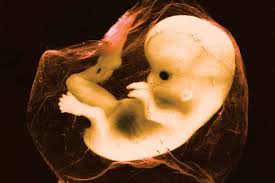
People who are staunchly pro-choice (i.e. who support the mother’s supposed right to have her unborn child killed at any time during the pregnancy for any reason) are usually at a loss to explain what precisely happens to the child so that it transitions from someone not protected by the law against murder to someone who is so protected. I have seen this over and over again in public debates between pro-abortion advocates and people like Ben Shapiro and Charlie Kirk.
Abortion advocates consistently refer to the unborn baby not “a baby” but “a fetus”, sharply differentiating between the two, not realizing that the word “fetus” derived from the Latin “fetus” which simply means “offspring”. They regard the fetus in the womb as devoid of legal protection so that it may be legitimately destroyed. However, once the child emerges from the womb they then regard it as a baby and as having the full protection of law so that killing it would now be regarded as murder.
Exactly how the six-inch trip down the vagina into the light of day bestows something so special on the child is not explained. Presumably the vagina is not magic and even if it was babies born through Caesarean section (which avoids the trip down the vagina) are still nonetheless regarded as protected by law against extermination.
Full formation of the unborn baby, completed after about nine months in the womb, is also not a factor because premature babies are also regarded as fully human and as deserving the protection of law. Indeed, I was present (i.e. nearby) for the birth of a very premature baby of a parishioner who weighed in at a pound and a half when she was born and today she is a fine lovely adult so clearly full formation in the womb is not required to qualify as fully human. We therefore ask again: what is required? The answer sometimes given: viability.
The argument goes like this: a baby in the womb is not viable whereas after it emerges from the mother it is viable. Legal protection against it being murdered therefore resides in its viability—i.e. its ability to live on its own outside the mother.
The argument has no merit, for it fails to understand what viability is and that all viability exists on a spectrum. Let’s look closer.
When the baby is (say) four months from being born, it is not viable. That is, it cannot feed itself or care for itself but it entirely dependent upon the mother for nourishment and warmth. It gets these from the mother more or less automatically through the umbilical cord and from being in her womb, protected from the cold. Later on when it is one week away from being born, it is still not viable but is dependent upon the mother for its nourishment and warmth. But after it is born it is still dependent upon the mother for its nourishment and warmth. These no longer are given by the mother internally (through the umbilical cord) but externally (through the breast and through being tucked into a warm crib).
And the point is this: one week after being born the baby is still not viable but is just as dependent upon the mother for its life as it was before it was born. The only difference is that now the gift of nourishment and warmth are given by the mother (or other caretaker) externally and voluntarily whereas before these gifts were given internally and (as it were) involuntarily.
One sees this lack of viability easily. If the mother leaves the baby alone and goes away for ten days of vacation she will return to find the baby has died because it was not viable—that is, it could not look after itself to feed itself or to keep itself warm. It would be the same if the baby was one year old: leaving the child alone for ten days would also result in the child’s death because at one year old the child is still not viable and able to look after itself.
When does the child become viable? Certainly by sixteen years the child can feed itself and keep warm and even before that. (The exact date of course depends upon how the child was raised.) So viability is found on a spectrum: later than one week, later than one year, earlier than sixteen years.
We see this too at the other end of the child’s life. Very old people can no longer fend for themselves, especially if they are afflicted by dementia or issues of limited mobility. Leaving them alone for ten days might also cause their death. Viability is therefore not something sudden and absolute, like the ability to breathe air through the lungs after emerging from the mother’s birth fluid. It is slow and gradual.
And therefore cannot be used as the basis of the child’s right to life. The baby emerging from the mother is still not viable. The right to life, in any truly ethical system, has to be rooted not in viability but in the fact that the person is alive. The sign of being alive is growth: if the baby is growing within the mother, the baby is alive—and therefore entitled to legal protection.
Of course, some cultures in the past have declined to be ethical. The Romans famously practised both abortion of the unborn and murder of newborns by exposure—especially if the newborn was a girl. In those cases they would simply dump the newborn on the street where it would be eaten by animals or perhaps taken in by someone so that it could serve as a slave—often a sexual slave, a prostitute. The Christians were famous for taking in such exposed infants to raise them honourably. (Such rescue is difficult now, since the preferred method of murder is abortion, not exposure. The most we can do is picket outside abortion clinics and risk arrest from a hostile government.)
The drive for access to unfettered abortion is part of a larger movement, one dedicated to the destruction of all past vestiges of Christian civilization (which includes a Christian understanding of gender and sexuality). This movement has violence at its center—a violence typified by the violent assault on the helpless unborn. Violence is both its goal and its raison-d’etre. The old values and way of life must be demonized, swept away immediately and utterly banished from the earth. This predilection to violence is why in debates with Ben Shapiro and Charlie Kirk the abortion advocates (along with their pro-gay and pro-trans comrades) are so often reduced to name-calling and insults. They cannot win a reasonable and civil debate and so they resort to verbal violence.
That violence is at the center of this movement also explains its consistent resort to riot, to the burning of cars and buildings, and attacks on officers of the law. An old 1975 Monty Python sketch (in their movie The Holy Grail) invited us to “Come and see the violence inherent in the system”. Here we may see the violence inherent in the ideology of the left. Unlike Monty Python sketches, it is not funny. And it seems that it is not going to go away any time soon.
